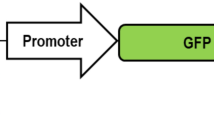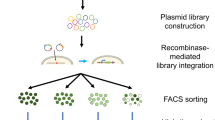Abstract
Using retroviral vectors encoding enhanced green fluorescent protein (egfp), we addressed to what extent expression of retroviral transgenes in hematopoietic cells depends on the multiplicity of infection (moi) and on the half-life of the encoded protein. we show that an elevation of the moi not only elevates the frequency of transduced cells, but also increases transgene expression levels and reduces interanimal variability in vivo (hematopoietic cells of c57bl/6j mice analyzed 13 weeks after transplantation). this suggests that the moi has to be carefully controlled and should be adapted as desired for clinical studies when evaluating vector performance in preclinical models. the impact of protein stability is demonstrated by comparing vectors expressing egfp or a destabilized variant with a c-terminal pest-sequence, d2egfp. the loss of expression with d2egfp was more pronounced in terminally differentiated cells of the peripheral blood (>30 fold) than in progenitor cells (five- to 10-fold), indicating a stronger transcription of the retroviral promoter in progenitor cells and a predominant role of protein inheritance over de novo synthesis of transgenic protein in mature blood cells. This analysis reveals an important and differentiation-dependent contribution of protein half-life to the expression of retroviral vectors in hematopoietic cells, establishes d2EGFP as a more accurate reporter for determination of vector transcription, and also suggests that preclinical data obtained under conditions of high transduction rates or with vectors expressing stable reporter proteins require careful interpretation.
This is a preview of subscription content, access via your institution
Access options
Subscribe to this journal
Receive 12 print issues and online access
$259.00 per year
only $21.58 per issue
Buy this article
- Purchase on Springer Link
- Instant access to full article PDF
Prices may be subject to local taxes which are calculated during checkout





Similar content being viewed by others
References
Cheng L, Fu J, Tsukamoto A, Hawley RG . Use of green fluorescent protein variants to monitor gene transfer and expression in mammalian cells Nat Biotechnol 1996 14: 606–609
Persons DA et al. Use of the green fluorescent protein as a marker to identify and track genetically modified hematopoietic cells Nat Med 1998 4: 1201–1205
van Hennik PB et al. Highly efficient transduction of the green fluorescent protein gene in human umbilical cord blood stem cells capable of cobblestone formation in long-term cultures and multilineage engraftment of immunodeficient mice Blood 1998 92: 4013–4022
Halene S et al. Improved expression in hematopoietic and lymphoid cells in mice after transplantation of bone marrow transduced with a modified retroviral vector Blood 1999 94: 3337–3349
Dunbar CE, Young NS . Gene marking and gene therapy directed at primary hematopoietic cells Curr Opin Hematol 1996 3: 430–437
Karlsson S . Treatment of genetic defects in hematopoietic cell function by gene transfer Blood 1991 78: 2481–2492
Baum C et al. Gene transfer and transgene expression in hematopoietic cells. In: Strauss M, Barranger JA (eds). Concepts in Gene Therapy DeGruyter: Berlin 1997; pp 233–266
Williams DA, Lemischka IR, Nathan DG, Mulligan RC . Introduction of new genetic material into pluripotent haematopoietic stem cells of the mouse Nature 1984 310: 476–480
Riviere I, Brose K, Mulligan RC . Effects of retroviral vector design on expression of human adenosine deaminase in murine bone marrow transplant recipients engrafted with genetically modified cells Proc Natl Acad Sci USA 1995 92: 6733–6737
Bunting KD et al. Transduction of murine bone marrow cells with an MDR1 vector enables ex vivo stem cell expansion, but these expanded grafts cause a myeloproliferative syndrome in transplanted mice Blood 1998 92: 2269–2279
Austin TW et al. Long-term multilineage expression in peripheral blood from a Moloney murine leukemia virus vector after serial transplantation of transduced bone marrow cells Blood 2000 95: 829–836
Arai T, Takada M, Ui M, Iba H . Dose-dependent transduction of vesicular stomatitis virus G protein-pseudotyped retrovirus vector into human solid tumour cell lines and murine fibroblasts Virology 1999 260: 109–115
Li X et al. Generation of destabilized green fluorescent protein as a transcription reporter J Biol Chem 1998 273: 34970–34975
Fehse B et al. CD34 splice variant: an attractive marker for selection of gene-modified cells Mol Ther 2000 1: 448–456
Emi N, Friedmann T, Yee JK . Pseudotype formation of murine leukemia virus with the G protein of vesicular stomatitis virus J Virol 1991 65: 1202–1207
von Laer D et al. Entry of amphotropic and 10A1 pseudotyped murine retroviruses is restricted in hematopoietic stem cell lines J Virol 1998 72: 1424–1430
Barrette S et al. Superior transduction of mouse hematopoietic stem cells with 10A1 and VSV-G pseudotyped retrovirus vectors Mol Ther 2000 1: 330–338
Hildinger M, Abel KL, Ostertag W, Baum C . Design of 5′ untranslated sequences in retroviral vectors developed for medical use J Virol 1999 73: 4083–4089
Abonour R et al. Efficient retrovirus-mediated transfer of the multidrug resistance 1 gene into autologous human long-term repopulating hematopoietic stem cells Nat Med 2000 6: 652–658
Williams DA, Hsieh K, DeSilva A, Mulligan RC . Protection of bone marrow transplant recipients from lethal doses of methotrexate by the generation of methotrexate-resistant bone marrow J Exp Med 1987 166: 210–218
Maze R, Hanenberg H, Williams DA . Establishing chemoresistance in hematopoietic progenitor cells Mol Med Today 1997 3: 350–358
Morgan RA . Genetic strategies to inhibit HIV Mol Med Today 1999 5: 454–458
Williams DA, Smith FO . Progress in the use of gene transfer methods to treat genetic blood diseases Hum Gene Ther 2000 11: 2059–2066
Kiem HP et al. Improved gene transfer into baboon marrow repopulating cells using recombinant human fibronectin fragment CH-296 in combination with interleukin-6, stem cell factor, FLT-3 ligand, and megakaryocyte growth and development factor Blood 1998 92: 1878–1886
Conneally E, Eaves CJ, Humphries RK . Efficient retroviral-mediated gene transfer to human cord blood stem cells with in vivo repopulating potential Blood 1998 91: 3487–3493
Schilz AJ et al. High efficiency gene transfer to human hematopoietic SCID-repopulating cells under serum-free conditions Blood 1998 92: 3163–3171
Schiedlmeier B et al. Quantitative assessment of retroviral transfer of the human multidrug resistance 1 gene to human mobilized peripheral blood progenitor cells engrafted in nonobese diabetic/severe combined immunodeficient mice Blood 2000 95: 1237–1248
Demaison C et al. A defined window for efficient gene marking of severe combined immunodeficient-repopulating cells using a gibbon ape leukemia virus-pseudotyped retroviral vector Hum Gene Ther 2000 11: 91–100
Hanenberg H et al. Colocalization of retrovirus and target cells on specific fibronectin fragments increases genetic transduction of mammalian cells Nat Med 1996 2: 876–882
Hagani AB et al. Activation conditions determine susceptibility of murine primary T-lymphocytes to retroviral infection J Gene Med 1999 1: 341–351
Wognum AW et al. Stimulation of mouse bone marrow cells with kit ligand, FLT3 ligand, and thrombopoietin leads to efficient retrovirus-mediated gene transfer to stem cells, whereas interleukin 3 and interleukin 11 reduce transduction of short- and long-term repopulating cells Hum Gene Ther 2000 11: 2129–2141
Miyoshi H et al. Transduction of human CD34+ cells that mediate long-term engraftment of NOD/SCID mice by HIV vectors Science 1999 283: 682–686
Case SS et al. Stable transduction of quiescent CD34(+)CD38(-) human hematopoietic cells by HIV-1-based lentiviral vectors Proc Natl Acad Sci USA 1999 96: 2988–2993
Ando K, Ajchenbaum-Cymbalista F, Griffin JD . Regulation of G1/S transition by cyclins D2 and D3 in hematopoietic cells Proc Natl Acad Sci USA 1993 90: 9571–9575
Baum C et al. Novel retroviral vectors for efficient expression of the multidrug-resistance (mdr-1) gene in early hemopoietic cells J Virol 1995 69: 7541–7547
Zufferey R, Donello JE, Trono D, Hope TJ . Woodchuck hepatitis virus posttranscriptional regulatory element enhances expression of transgenes delivered by retroviral vectors J Virol 1999 73: 2886–2892
Agarwal M et al. Scaffold attachment region-mediated enhancement of retroviral vector expression in primary T cells J Virol 1998 72: 3720–3728
Baum C et al. The potent enhancer activity of the polycythemic strain of spleen focus-forming virus in hematopoietic cells is governed by a binding site for Sp1 in the upstream control region and by a unique enhancer core motif, creating an exclusive target for PEBP/CBF J Virol 1994 71: 6323–6331
Kinsella TM, Nolan GP . Episomal vectors rapidly and stably produce high-titer recombinant retrovirus Hum Gene Ther 1996 7: 1405–1413
Grande A et al. Transcriptional targeting of retroviral vectors to the erythroblastic progeny of transduced hematopoietic stem cells Blood 1999 93: 3276–3285
Acknowledgements
We thank Cordula Grüttner for excellent technical assistance. This work contains parts of the doctoral thesis of Anke Wahlers (University of Hamburg, Faculty of Biology). This work was supported by the Deutsche Krebshilfe (10–1456-Ba2), by the Erich and Gertrud Roggenbuck-Stiftung and by the Hamburger Stiftung zur Foerderung der Krebsbekämpfung. The Heinrich-Pette-Institute is financially supported by the Freie und Hansestadt Hamburg and by the Bundesministerium für Gesundheit.
Author information
Authors and Affiliations
Rights and permissions
About this article
Cite this article
Wahlers, A., Schwieger, M., Li, Z. et al. Influence of multiplicity of infection and protein stability on retroviral vector-mediated gene expression in hematopoietic cells. Gene Ther 8, 477–486 (2001). https://doi.org/10.1038/sj.gt.3301426
Received:
Accepted:
Published:
Issue Date:
DOI: https://doi.org/10.1038/sj.gt.3301426
Keywords
This article is cited by
-
Scalable manufacturing of gene-modified human mesenchymal stromal cells with microcarriers in spinner flasks
Applied Microbiology and Biotechnology (2023)
-
Multi-experiment nonlinear mixed effect modeling of single-cell translation kinetics after transfection
npj Systems Biology and Applications (2018)
-
Retroviral insertional mutagenesis in telomerase-immortalized hepatocytes identifies RIPK4 as novel tumor suppressor in human hepatocarcinogenesis
Oncogene (2015)
-
Real-time Fluorescence Tracking of Dynamic Transgene Variegation in Stem Cells
Molecular Therapy (2007)
-
RhoH GTPase recruits and activates Zap70 required for T cell receptor signaling and thymocyte development
Nature Immunology (2006)



